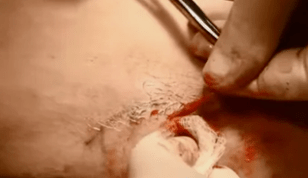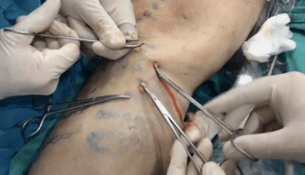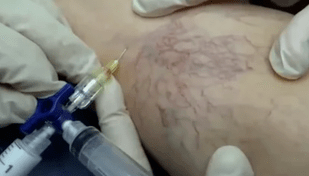If the first stage of varicose veins is treated very effectively with conservative methods, then the progression of the disease in stages 2 and 3 can only be cured by surgery, medicines and other methods can only stop the progression of the pathology. This article will discuss the main surgical methods for the treatment of varicose veins, the features of their application, etc.
Indications for surgical intervention

Due to the fact that in the first stage of varicose vein development, surgical intervention is extremely rare due to lack of need, a very important factor is the indication for surgery. The decision is based on the data obtained during the detailed diagnosis of blood vessels, and is taken by the patient together with the doctor.
A phlebologist is obliged to tell about the risks of the proposed surgery, the duration and nuances of postoperative rehabilitation, which are then performed only with the patient's consent.
As for the indications themselves, surgery for varicose veins is necessary in such cases:
- Pathological dilation and subsequent deformation of purely saphenous veins of the second degree of severity and above. Wide forms of varicose veins, the disease affects not only the saphenous veins, but mostly deep veins, or the deformation of the vessels extends to a very large area of the lower extremities.
- There is a serious circulatory disorder, accompanied by severe stagnant blood processes.
- Severe forms of edema, high-intensity pain syndrome, accompanied by distinct external (aesthetic) signs of varicose veins.
- Formation of trophic ulcers on the skin or subcutaneous hematoma due to impaired vascular integrity;
- Progression of the pathological process to the blockage of venous vessels and the development of an acute form of thrombophlebitis.
- Lack of positive dynamics during conservative treatment, i. e. when medications and other methods of treating varicose veins are powerless.
Limitations and contraindications for surgery
Unfortunately, even with the development of severe forms of varicose veins, accompanied by complications and a severe clinical picture, it is not always possible for a patient to undergo surgery.
There are a number of contraindications, which, if they do not completely rule out the possibility of surgical intervention, are forced to postpone the operation for a certain period of time:
- Ischemic heart disease - in this case, it is necessary to perform a more comprehensive examination.
- The same goes for grade 3 hypertension
- Active infectious and inflammatory processes in the body - before performing surgery to treat varicose veins, you must fight the infection or eliminate the inflammation.
- Second and third trimester of pregnancy - for pregnant women, it is better to postpone any surgical procedure until the woman gives birth. The only exceptions are cases where there is a serious risk to the life of the mother or child and surgery can help.
- Skin disease in the area of surgery to fight varicose veins. We are talking about eczema, various forms of dermatosis, etc.
- There are also certain age restrictions, of course, for seniors. In some cases, old age, as well as concomitant diseases of old age, increase the risk of postoperative complications or endanger a person's life at the operating table.
Methods of surgical intervention for varicose veins
If, however, the doctor, based on the diagnosis and after examining the patient, is sure of the need for surgical intervention, it remains to choose the most appropriate and effective method, depending on the degree of progression of varicose veins and a rangeother factors. To understand what surgeries are and in what cases they are performed, we will examine the most effective methods of surgical treatment of varicose veins.
Combined phlebectomy

A complete operation performed under general anesthesia and may take up to 2 hours, depending on the complexity of the task. Phlebectomy can be used to treat the initial forms of varicose veins, but more often this method is used in advanced cases, when the disease has progressed seriously.
During surgery, the surgeon makes an incision up to 2 inches long for the ankle, or up to 5 inches for a wider area such as the hip. Often, these incisions are shallow, as the superficial veins are mostly removed.
The principle of the operation is to connect the anastomosis of the vessel with the subsequent removal of the part of the vein affected by the varicose veins. Also, during surgery, the surgeon can correct the venous valves in order to restore normal blood flow.
At the end of the operation, cosmetic sutures are placed on the incisions, a dressing is made and an elastic bandage is placed on the operated area to prevent bleeding.
Miniflebektomi
During this procedure, the affected area of the vein is also cut, however, the rate of surgery is smaller, it can be considered purely cosmetic. The conclusion is that the doctor makes a small puncture in the skin, through which he removes a part of the vein to be cut. This operation is performed mainly on small vessels, and its advantages are painless (due to local anesthesia) and a minimal recovery period.
Scleotherapy
A relatively new technique, a minimally invasive method, which is famous for its effectiveness, as well as the lack of painful sensations due to the same local anesthesia and practically without a rehabilitation period.

The procedure involves inserting a special substance into the lumen of the vein - a foamy sclerosing agent. This substance leads to the collapse of the vessel walls with their subsequent adhesion. As a result, the vein ceases to participate in the circulatory process, is gradually resolved and replaced with connective tissue.
The method of sclerotherapy is mainly used to eliminate small superficial vessels, as well as to get rid of the so-called "spider veins".
Laser coagulation
The most modern way and, according to many experts, an effective way to deal with varicose veins. Its essence lies in the fact that a laser light guide is inserted into the venous lumen through an aperture of only 2 mm. When the latter is activated, it begins to emit laser waves, the temperature rises inside the vessel and as the laser is removed, the walls of the vein collapse and stick together. The vessel then disappears on its own, being replaced by connective tissue.
Of course, the main advantage of this procedure is the almost complete absence of visible skin lesions, as well as the lack of need for a rehabilitation period.
Possible consequences
Even the mildest surgery leaves a mark and can have consequences. First of all, this is due to the fact that the anatomical component of the body has been removed - a complete vessel. Of course, with combined phlebectomy, such consequences can be much more serious than some bruising after laser coagulation.
Let us consider the most basic consequences that occur periodically after a particular type of surgical treatment:
- When you eliminate varicose veins using minimally invasive methods, excluding vessel removal, there is a risk of recurrence. This risk is minimal only during laser coagulation, only 5%.
- Burns - occur after operations during which thermal effects are applied. Bleeding - can start after any intervention, but most likely after a phlebectomy.
- There are also known cases of nerve damage, but this factor refers only to the level of professionalism of the surgeon.
Rehabilitation process
Rehabilitation, ie recovery after surgery, is required in each of the cases described, but if after coagulation this process lasts only a few days, then after a combined phlebectomy it may take several weeks. In order for recovery to go smoothly and quickly, it is important to follow the simple recommendations:
- Follow your doctor's advice carefully.
- Wear compression garments or elastic bandages.
- If cuts have occurred, it is important to wait for them to heal.
- Once the cuts have healed, it is important to restore physical activity, exercise therapy and regular walking will help with this.
- If your doctor has prescribed any medicine, take it according to these instructions.
- It is also helpful to visit a masseur after surgery and to prevent varicose veins.
- Avoid serious physical exertion for at least 2-3 months.
If the operation went well and the patient fully followed the doctor's instructions for recovery, the chances of a favorable outcome are very high. In most cases, varicose veins can be cured, but this does not mean that the disease can not affect other vessels. For this reason, prevention of varicose veins should always be performed if there have been cases of development of this pathology.




































